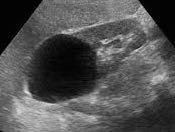Andrew Siegel MD 4/25/15
Kidney cysts, a.k.a. renal cysts, are balloon-like sacs that are fluid filled and are located within or attached to the kidney. The vast majority of renal cysts are not symptomatic nor dangerous and are discovered incidentally on imaging studies (ultrasound, computerized tomography, or magnetic resonance imaging) done for reasons unrelated. Renal cysts are very common, occurring in about 25% of adults over age 40 and 50% of adults over age 50. They can be variable in size, ranging from smaller than a pea to larger than a cantaloupe.
Most renal cysts are simple cysts. They are spherical in shape, have a very thin wall, are filled with fluid, do not contain septa (divisions within the walls), calcifications, or solid parts and do not enhance (take up contrast) on imaging studies. They have the appearance of variable-sized water balloons, are benign, and simply need to be followed as they will rarely evolve into a problematic situation. Although large cysts may become symptomatic by compressing adjacent organs, this is unusual. Only very rarely do simple cysts require treatment or intervention. Ultrasound (sonography) is a non-invasive technique that does not require radiation nor contrast injection and is used for determining the number, location, and size of cysts and is also an excellent means of following them over time.
The following image is an ultrasound of a simple renal cyst:
Although most renal cysts are simple benign cysts, there are more complicated cysts, on occasion being a cystic malignancy of the kidney. If a cyst has a thickened wall or the presence of internal components (septa), calcifications, or it enhances with contrast, it is not classified as a simple cyst, but as a complex cyst.
The current classification of renal cysts is the Bosniak system, named after Dr. Morton Bosniak, the radiologist who devised this system:
I Simple benign cyst with a thin wall and no septa, calcifications, or solid components. It is the tissue density of water and does not enhance with contrast. Malignancy potential: 0%.
II Benign cyst that may contain hairline septa. Calcification may be present in the wall or septa, but does not enhance with contrast. Malignancy potential: 0-10%.
IIF (F for follow-up) Cyst that may contain hairline septa. Minimal enhancement may be seen in the wall or septa and may contain calcifications. No soft tissue enhancing elements present. Malignancy potential: 5-25%.
III Cystic mass that has thickened irregular walls or septa in which enhancement is present. These need to be explored surgically, although some will prove to be benign, including hemorrhagic cysts, chronic infected cysts, and multi-loculated cystic nephroma, while some will be malignant including cystic renal cell carcinoma. Malignancy potential: >50%.
IV Clearly malignant cystic masses that contain enhancing soft tissue components. These include cystic carcinomas and require surgical removal. Malignancy potential: > 90% .
Bottom Line: The vast majority of renal cysts are found incidentally and are simple benign cysts that will never cause symptoms or problems. They are easily followed up with ultrasound and rarely require intervention.
Wishing you the best of health,
![]()
AndrewSiegelMD.com
A new blog is posted every week. To receive the blogs in your email in box go to the following link and click on “email subscription”:
Author of Male Pelvic Fitness: Optimizing Sexual and Urinary Health: available in e-book (Amazon Kindle, Apple iBooks, Barnes & Noble Nook, Kobo) and paperback:
http://www.MalePelvicFitness.com
Co-creator of Private Gym pelvic floor muscle training program for men:
The Private Gym is a comprehensive, interactive, follow-along exercise program that provides the resources to strengthen the pelvic floor muscles that are vital to sexual and urinary health. The program builds upon the foundational work of Dr. Arnold Kegel, who popularized exercises for women to increase pelvic muscle strength and tone. This FDA registered program is effective, safe and easy-to-use. The “Basic Training” program strengthens the pelvic floor muscles with a series of progressive “Kegel” exercises and the “Complete Program” provides maximal opportunity for gains through its patented resistance equipment.
Tags: Andrew Siegel MD, Bosniak classification, complex cyst, kidney, renal cysts, renal ultrasound, simple cyst

Leave a comment